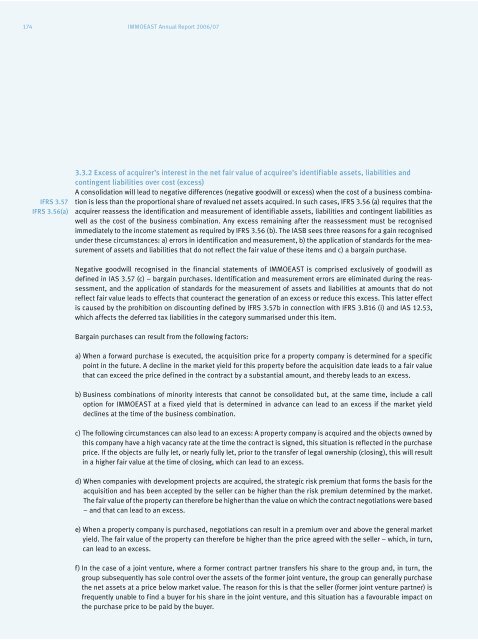IMMOEAST Annual Report 2006/07
IMMOEAST Annual Report 2006/07
IMMOEAST Annual Report 2006/07
Create successful ePaper yourself
Turn your PDF publications into a flip-book with our unique Google optimized e-Paper software.
174 <strong>IMMOEAST</strong> <strong>Annual</strong> <strong>Report</strong> <strong>2006</strong>/<strong>07</strong><br />
IFRS 3.57<br />
IFRS 3.56(a)<br />
3.3.2 Excess of acquirer’s interest in the net fair value of acquiree’s identifiable assets, liabilities and<br />
contingent liabilities over cost (excess)<br />
A consolidation will lead to negative differences (negative goodwill or excess) when the cost of a business combination<br />
is less than the proportional share of revalued net assets acquired. In such cases, IFRS 3.56 (a) requires that the<br />
acquirer reassess the identification and measurement of identifiable assets, liabilities and contingent liabilities as<br />
well as the cost of the business combination. Any excess remaining after the reassessment must be recognised<br />
immediately to the income statement as required by IFRS 3.56 (b). The IASB sees three reasons for a gain recognised<br />
under these circumstances: a) errors in identification and measurement, b) the application of standards for the measurement<br />
of assets and liabilities that do not reflect the fair value of these items and c) a bargain purchase.<br />
Negative goodwill recognised in the financial statements of <strong>IMMOEAST</strong> is comprised exclusively of goodwill as<br />
defined in IAS 3.57 (c) – bargain purchases. Identification and measurement errors are eliminated during the reassessment,<br />
and the application of standards for the measurement of assets and liabilities at amounts that do not<br />
reflect fair value leads to effects that counteract the generation of an excess or reduce this excess. This latter effect<br />
is caused by the prohibition on discounting defined by IFRS 3.57b in connection with IFRS 3.B16 (i) and IAS 12.53,<br />
which affects the deferred tax liabilities in the category summarised under this item.<br />
Bargain purchases can result from the following factors:<br />
a) When a forward purchase is executed, the acquisition price for a property company is determined for a specific<br />
point in the future. A decline in the market yield for this property before the acquisition date leads to a fair value<br />
that can exceed the price defined in the contract by a substantial amount, and thereby leads to an excess.<br />
b) Business combinations of minority interests that cannot be consolidated but, at the same time, include a call<br />
option for <strong>IMMOEAST</strong> at a fixed yield that is determined in advance can lead to an excess if the market yield<br />
declines at the time of the business combination.<br />
c) The following circumstances can also lead to an excess: A property company is acquired and the objects owned by<br />
this company have a high vacancy rate at the time the contract is signed, this situation is reflected in the purchase<br />
price. If the objects are fully let, or nearly fully let, prior to the transfer of legal ownership (closing), this will result<br />
in a higher fair value at the time of closing, which can lead to an excess.<br />
d) When companies with development projects are acquired, the strategic risk premium that forms the basis for the<br />
acquisition and has been accepted by the seller can be higher than the risk premium determined by the market.<br />
The fair value of the property can therefore be higher than the value on which the contract negotiations were based<br />
– and that can lead to an excess.<br />
e) When a property company is purchased, negotiations can result in a premium over and above the general market<br />
yield. The fair value of the property can therefore be higher than the price agreed with the seller – which, in turn,<br />
can lead to an excess.<br />
f) In the case of a joint venture, where a former contract partner transfers his share to the group and, in turn, the<br />
group subsequently has sole control over the assets of the former joint venture, the group can generally purchase<br />
the net assets at a price below market value. The reason for this is that the seller (former joint venture partner) is<br />
frequently unable to find a buyer for his share in the joint venture, and this situation has a favourable impact on<br />
the purchase price to be paid by the buyer.


